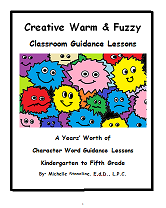Helping Kids Behave
By: Dr. Paul Clements
School Psychologist
The purpose of this paper is to put down into short form, some basic principles of dealing with children who have difficulty behaving. This has been gleaned from classroom experience, workshops, and working with children. It also includes the author’s philosophy of how to work with children who have problems behaving.
As such it serves as the framework to determine where one is and where one will need to go. In addition this can then also serve as a quick reference when one needs a quick check of what to do in a particular situation.
There is a reference list for those who wish to review some of these techniques in more detail. This paper is targeted to those who still think children are just “supposed to behave” and that if they don’t behave, then just send them somewhere else.
While a teacher SHOULD be able to keep order with a word and a call home, that is not the case in the modern world. Both State and Federal regulations increasingly indicate that ALL children must stay in school somewhere.
If order can be maintained in the regular classroom and children who have problem behaviors can be educated along with their peers, so much the better. This is not a prescription to be used with every student. It, hopefully, will be a guide that one can use to create a more disciplined classroom.
A key element all the way through is your relationship with the student. The experience and research of all those quoted and referenced is that a teacher must have a positive relationship with the student in order to reach that student. In other words you must like them, care for them and even love them or make them THINK you DO.
I don’t mean that one is to be insincere. It is the adult’s responsibility to take the first step to break the conflict cycle by looking at the positive side of the child.
The second is more a challenge that seems to apple to school systems, “When we see that wounded traveler on the road to Jericho we will not pass to the other side.” In this author’s experience, most of your behavior problem children have been wounded by abandonment and neglect or by a “failure of love”.
So how does one make them think you like them; by speaking the behavioral language of caring. Gary Chapman (1992) calls this the five love languages.
By this he means that there are five types of things that we can do which make another person feel that we care about them or love them.
If you DO things that say I care such as acts of service, a touch , a kind word, then the child or adolescent will feel that you care. This will be gone into in more detail below. The sad truth is in many cases the teacher may be the only person the child does think likes, cares, or loves them.
This is the first principle for managing student behavior. As Chapman (2000) points out people accept leadership when they think and feel you are putting their best interests first.
It won’t solve all of your problems, but it will give you a shot at changing the student’s behavior; a shot is all anyone really gets at anything. So if you don’t like children, or if you only like children who are well behaved, you may not be best suited for a career as a school teacher.
Relationship:
The first principle is that you must form a relationship with the child. The bottom line is that you must care and show the child you care if you are to have a chance to maintain control and change the child’s behavior. This must be sincere.
Most people can tell when you are not sincere. If you really don’t like the child, make him or her THINK YOU DO. A superintendent once told this author that parents may not send schools the best students every day but they were sending the schools the best they have. One principle of Social Psychology is that behavior can change perceptions and emotions.
If a person is treated nicely for a period of time, and they see that the person who is treating them nicely has nothing to gain, then they usually conclude that the person is being nice because he or she likes them.
Davis, Nelson, and Gauger (2000) in their book The Boys Town Model: Safe and Effective Secondary School, make it plane that building a relationship with the child is the cornerstone of the boys town program. GEMA (2000) also identifies having one adult they can trust and admire as one of the key factors of the resilient child.
In addition author Jane Bluestein (2001) notes one counselor identified two saving graces for students to feel safe. First having one person or persons who respects and values them as an individual. Second having a place to succeed.
In this authors experience self-esteem is built upon experiences of success that are valued by at least one important person in your life. Strive to be the adult that a child learns to trust and admire. If by now you think this is a bunch of garbage you may quit reading and resign yourself to a very long year.
Positive Behavior Page
Creative Counseling 101 Home
Disclaimer: This website and its content is intended for trained licensed mental health professionals and school certified mental health professionals to use for their clients / students at their own discretion.
*If you ignore the disclaimer above are using these techniques on yourself and you feel any discomfort or upset it is highly suggested that you seek out a licensed mental health professional immediately.
"Beyond Art Therapy" is the concept from Dr. Stangline that combines all creative fields in therapy. It is not the traditional "art therapy" but goes beyond to include sand tray therapy, play therapy, mindfulness, meditation, color therapy, cognitive behavioral therapy, and a vast majority of other therapies.
For any other type of mental health emergency call your local 911 / Police Number immediately.
Dr. Stangline does not offer advice / suggestions to anyone who is not a professional mental health provider, or a student who is studying this field and has questions about mental health programs of study.
See our Exciting Selection of eBooks:
Award Winning:
Creative Counseling 101 eBook
Our Best Seller!
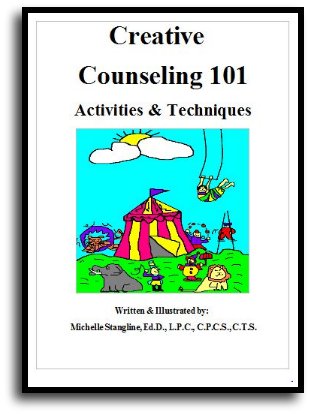
Step By Step Therapy:
Learn how to be a more Creative Therapist with the Book that started it all!
- Graduate School Counseling book used by hundreds of graduate counseling students!
- Includes full color reproducible worksheets with most activities.
- Winner of the Counselor Writer of the Year Award, 2011, Georgia Regional Award
Download Your Copy Today Only $39.95:
See Creative Counseling 101 eBook Information Here:
Get the Set
of all four
eBooks for only $98.95:
An incredible collection of how to do therapy eBooks!
A $159.80 Value,
You Save Over $60!
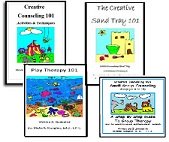
Get your complete set of the Creative Counseling 101.com eBooks by Dr. Michelle Stangline for only $98.95, that's less than $25.00 per eBook (Regular Price is $39.95 for each eBook.).
Your complete set includes:
- Creative Counseling 101
- Creative Group Counseling 101
- Creative Play Therapy 101
- Creative Sand Tray 101
For more information click the link below:
See Complete Set of eBooks For Sale Here:
New!!! "Beyond Art Therapy" 101 eBook
Over 300 pages of Beyond Art Therapy activities and techniques. Learn what I teach graduate counseling students!
See the link below for more information.
Only $39.95
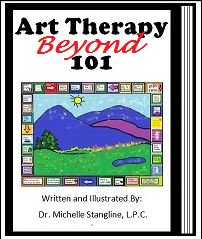
See More Invividual eBooks For Sale:
Sand Tray Therapy 101 eBook:
Learn how to do Sand Tray Therapy or enhance your skills.
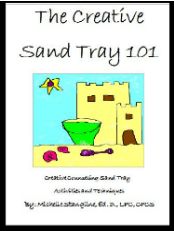
Play Therapy 101 eBook
Learn how to do play therapy or enhance your skills.
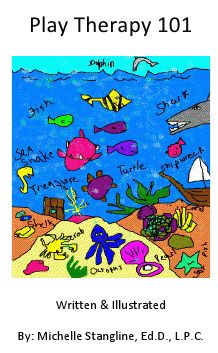
Small Group Counseling eBook For Sale:
Learn how to do creative group therapy and enhance your skills.
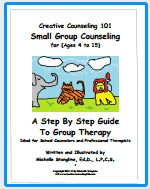
School Counselor Guidance Lesson & Social Stories eBook for sale:
Get a year's worth of school counselor guidance lessons with "Creative Warm & Fuzzy Classroom Guidance Lessons eBook". Introduce your students to the "Warm & Fuzzy Way". Click the link below for more information:
Warm & Fuzzy School Counselor Guidance Lessons eBook
